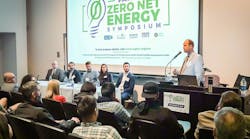The future of homebuilding and its alignment with California’s advanced energy goals took center stage a couple of weeks at A Path to Zero Net Energy Symposium held at Fresno State University. University students from related fields joined homebuilders, real estate agents, urban planners and government officials for a discussion on everything from ZNE building science technology, policy updates and ZNE market value to decarbonization in California and advancements to California’s electrical grid.
The symposium was led and moderated by Fresno State faculty representing three disciplines linked to Zero Net Energy (ZNE). Commissioner Andrew McAllister of the California Energy Commission (CEC) delivered the keynote address.
“To reach California’s ambitious climate and energy goals, we must push past status quo thinking to get the most out of each construction investment,” said Commissioner McAllister, California Energy Commission’s lead on energy efficiency and buildings. “This extends to not only residential construction, but also commercial construction and renovation of State buildings. To get the high level of performance we need from our buildings, each project must apply the most up-to-date clean technologies and practices, taking care to achieve long-lasting, quality installation.”
For a home to be considered ZNE, it must be exceptionally energy efficient and designed with the potential to produce – through renewable energy sources – as much clean energy as it consumes in a year.
Among the presentations were discussions of the real-world experiences of moving ZNE from custom and one-off installations to mainstream production by Garth Torvestad, senior technical consultant for ConSol, and Brandon De Young, executive vice president, De Young Properties. The companies have partnered to build and study over 100 ZNE homes in Clovis, CA, making up the two largest single-family ZNE subdivisions in the state. The symposium included a tour of the De Young SmartHome Experience Center highlighting the company’s effort to expand public education on the benefits of ZNE construction both financially and environmentally.
Read more about the symposium here: Central Valley Leads California’s Green Homebuilding Education with A Path to Zero Net Energy Symposium!



